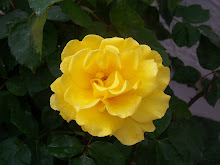Yule for me is a time of paradox. As the darkness deepens in the waning year, I go deeper within. It is a time for solitude and reflection. And yet it is also a time for the community to come together.
Years ago, as an adolescent I loved gymnastics. Right before the start of a floor routine, I would experience a moment of perfect, poised stillness. With my breath the only movement, I mentally went over the routine, correcting previous errors, stretching to do better than before. Then the music started, and stillness was replaced with deliberate action. The winter solstice is like that for me, a moment of concentration right before the music starts.
The celestial event of the solstice occurred a little over two hours ago, so now the year is officially waxing, although it is still tender and new. It is pure and unmarked, a ski trail covered in fresh powder without tracks. We may write upon it however we wish. We may repeat last year's errors, or we may blaze a new trail. It is our own choice.
As we privately make these choices, we also experience the community aspect of Yule.
This morning, while reading The Story of the Yule Log to my children, as I do each year, it occurred to me that my definition of community has expanded a bit since I wrote that story.
At the time, the story was written specifically for the pagan community of which I am a part. We were, and still are, a group of people spread out over a certain geographic region, with tendrils reaching out all over the country and the world. While we are friends and mostly quite fond of one another, many of us connected mostly during specific auspicious occasions. Many of us did not experience in each other the type of close-knit interdependence of a tribe from earlier times.
What I was missing is this point: We are just as dependent upon community as ever. "Community" is simply more complex than it was. "Community" is also the business community, which brings in the goods that we rely upon on a day to day basis. It's also the public schools our children attend, and it's the medical community, and much more. A few days ago, one of my children had a procedure called a swallow study. A radiologist, radiology technician, speech therapist and occupational therapist met to obtain and interpret the results of the procedure. As they waited to begin the procedure, they chatted, catching up on personal news, sharing the latest ideas. They are definitely a part of community, and my son depends on them to help him begin to eat correctly and end his dependence on a gastrostomy tube. This dependence is no less profound than a small tribe's dependence on the hunting party to return with fresh meat. Where would we be without the hospitals when our loved ones are sick or injured?
Obviously, we would be just as lost without community today as ever before.
So at Yule, we exchange gifts, and donate to charities. We come together and express our care for one another.
Last year, my youngest child began to figure out the whole Santa Claus thing. He asked me if Santa Claus is real, and I said, firmly, "Yes. Santa Claus is real." I said that it's just that little children need to see things in a more concrete way. I told them that now that he is bigger, he is starting to be able to think in abstract terms. Santa Claus might not really be a man in a red suit, but that doesn't make him less real. Santa Claus, for grownups, is an idea, a philosophy and a choice. He is the generosity in the human heart. If we choose to, we can all be Santa - when we give to Toys For Tots, or when we bring food donations to a community pantry, or in a hundred other ways. When a child experiences the man in the red suit, it helps him to connect his own specific, personal inner generosity with the general, universal generosity of the human heart. For me, the archetype of Santa Claus embodies our amazing potential to help one another. One might say he is a symbol for community in winter.
Monday, December 21, 2009
Subscribe to:
Posts (Atom)
